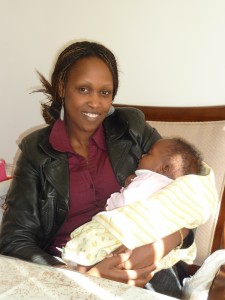On Tap
 Up from the Prison of Hate
Up from the Prison of Hate
With Josee Uwamahoro,
survivor of the Rwandan genocide
Research in process, supported by a grant from the Alberta Foundation for the Arts
Beaten, her clothes shredded, thrown down a hole and all-but buried in sand, 17-year-old Josee Uwamahoro had no reason to expect she’d survive. In more than a month of panicked cat-and-mouse through the Rwandan forest south of Kigali, often just a shadow away from machete-wielding gangs, she’d seen what deadly instruments her Hutu neighbours had become. Screams, sickening thuds, bloodied stumps, classmates killing classmates—it was the stuff of nightmares. A cauldron of hate boiling over and infecting all it touched. Turning any person with Tutsi blood into a cockroach to be crushed.
One by one, Josee’s family had dwindled. Then it was Josee’s turn. Three days in the hole, she swam in and out of consciousness, her body bloating and numb atop rotting corpses.
Miraculously, two toddlers found her there and ran to find help. And so she was rescued. But her body refused to work and her tears seemed never to end. Nor was that the last of the dangers she faced as her mixed-affinity rescuers, and later her doctors, debated what to do with this stinking, damaged Tutsi.
Pronounced paralyzed for life, Josee sank into her misery, willing herself to die and arguing with God. Slowly, her arguments shifted, from “How do you think I’m going to survive like this?” to “The Bible says everything is possible.” Shutting the door to her room, she doggedly dragged herself onto crutches and tried her best to walk, day after falling down day.
Josee now lives in Edmonton with husband Jules (who also lost most of his family to the genocide) and their children Egon and Edna. Invited in early 2010 to speak at a conference exploring the importance of home, she stood quietly confident before a packed room, searching for words (in what is still a somewhat foreign tongue) to describe how she can be at home in Alberta.
“You may think, ‘After all she’s been through, how does she make another family?’” she said. “The only thing I can tell you about building another home is just having hope.”
In remarkable ways, Josee has climbed from the prison of hate by imagining a different future, both for her family and for the country of her birth. Yet she still carries a burden of untold grief that she believes is keeping her and thousands more from moving forward. That’s why she wants her story known. To shift the focus from hate to forgiveness. From despair to hope. “When you have hope,” she says, “anything can happen.”
Josee has asked me to tell her story, and I am honoured to accept the challenge.
If you have insights and memories to offer about the Rwandan genocide and what has happened since, email cheryl@wordsthatsing.com
 Women Building Alberta
Women Building Alberta
Stories of the pioneering architects
who chipped away at gender barriers
Research ongoing.
Many of Canada’s earliest woman architects have strong ties to Alberta. and a growing number of women are entering the profession. Yet relatively few women go on to become registered architects. And we still talk of our architecture as “manmade.”
My interest in this topic was piqued while preparing an article for Alberta Venture on Vivian Manasc, partner in Manasc Isaac Architects. Along the way, historian David Murray observed that architecture has been anything but kind to women, but that certain women in Alberta were among the first to defy the odds.
That conversation led to an article for Legacy magazine tracing the path Alberta women have taken into architecture. I was intrigued to find that women architects in Alberta scored numerous firsts in the earlier years of the 20th century, but have lagged behind the rest of Canada since the late ’70s.
Looking back, this province can boast the first woman to graduate in architecture, the first school of architecture to accept a female student, the first architectural association to accept a woman registrant, the first all-woman partnership. Alberta and Manitoba had by far the highest proportion of women among registered architects in 1960; decades earlier, in 1916, those two and a third prairie province, Saskatchewan, were first to enfranchise women.
Earliest Alberta women trained as architects
- Alice Charlotte Ross
Earliest Canadian woman to graduate in architecture, 1910
- Marjorie Hill
First woman to register as an architect, 1925
- Margaret Dell Buchanan
First woman to graduate in architecture from the University of Alberta, 1937
- Jean Louise Emery Wallbridge & Mary Louise Imrie
First all-woman partnership, 1951
- Margaret Findlay
Graduates with Wallbridge from U of A, 1939
- Doris Newland Tanner
University of Manitoba graduate (1944) who combines career and family
- Freda M. O’Connor
First woman in Canada elected to an architectural council, 1964, and first elected president, by the Alberta Association of Architects in 1974
Toronto architect and scholar Blanche Lemco van Ginkel attributes this more generous acceptance of women as “persons” to “the role that pioneering women had played in a tough territory.” University of Toronto’s Annmarie Adams and Petra Tancred echo van Ginkel’s thesis in Designing Women: Gender and the Architectural Profession. In times of major upheaval, they argue, women come to the fore by taking “the risks inherent in new social conjunctures.”
Women Building Alberta aims to tell Alberta’s story just as Designing Women presented the cross-Canada perspective. I want to bring Alberta women architects out of the shadows, both to recognize what they accomplished and to provide role models for the generations that follow. To that end, I’m continuing to prowl for the contacts, vignettes and images needed to help us understand Alberta’s early women architects in the context of their times.
If you have thoughts and memories to offer about Alberta’s earliest women architects, email cheryl@wordsthatsing.com


Leave a Reply
You must be logged in to post a comment.